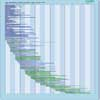Multi-Purpose Imagery (Land)
Measurements
Measurements > Land > Multi-purpose imagery (land) The spatial information that can be derived from satellite imagery is of value in a wide range of applications, particularly when combined with spectral information from multiple wavebands of a sensor. Satellite Earth observation is of particular value where conventional data collection techniques are difficult, such as in areas of inaccessible terrain, providing cost and time savings in data acquisition – particularly over large areas. At regional and global scales, low resolution instruments with wide coverage capability and imaging sensors on geostationary satellites are routinely exploited for their ability to provide global data on land cover and vegetation. |
| Active Fire Detection | Techniques that map active (or flaming) fires. | 8 instruments |  |
| Fire fractional cover | Fraction of a land area where fire is occurring - Physical unit [ % ], Accuracy unit [ % ] | 40 instruments |  |
| Glacier topography | Relates to glacier thickness typically found in mid to high latitudes with a volume/area coverage much smaller than an ice-sheet. [Unit of measurement - cm] | 3 instruments |  |
| Land surface imagery | Level-1 product (not a geophysical parameter). High-resolution imagery covering wavelengths in the range 0.4-1 µm (cloud-affected) or 1-10 GHz (SAR, all-weather) - Accuracy expressed as Modulation Transfer Function (MTF) at the Nyquist spatial wavelength (twice the resolution). Actually [ MTF-1 ] is used, so that smaller figures correspond to better performance, as usual. | 138 instruments |  |
| Mineral Type | A mineral is a naturally occurring chemical compound, usually of crystalline form and abiogenic in origin. Whereas a rock can be an aggregate of different minerals, a mineral has one specific chemical composition. There are over 5,300 known mineral species. In remote sensing, specific minerals can be detected by their spectral signatures and other characteristics. | 5 instruments |  |
| Surface Coherent Change Detection | Techniques that exploit the changes between two or several radar images of the same scene, in conditions where there is measurable coherence between at least a fraction of a pair of images, to detect subtle differences in the surface condition that can be related to sub-wavelength motions, surface properties changes or sub-pixel disturbances. | 5 instruments |  |
|